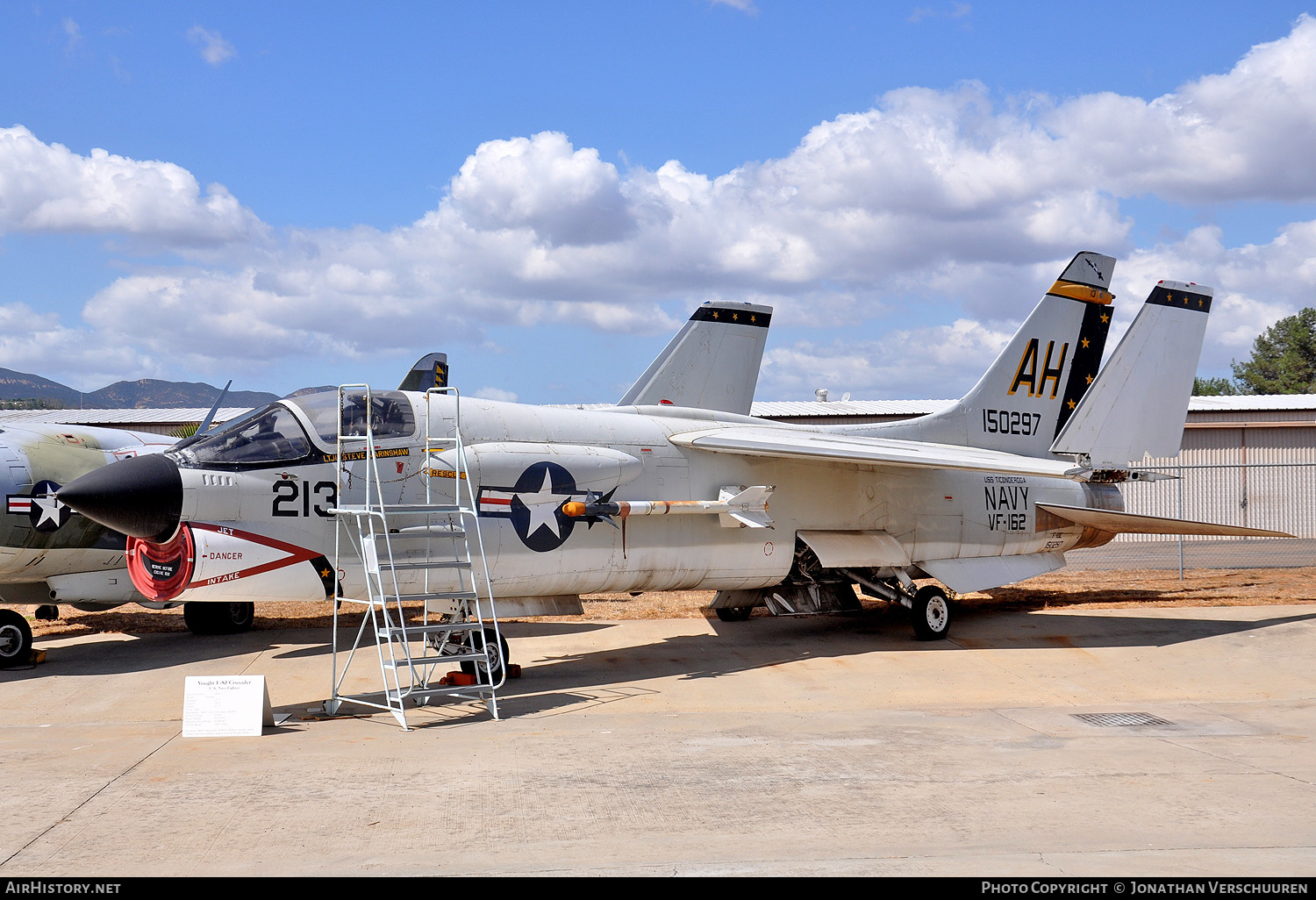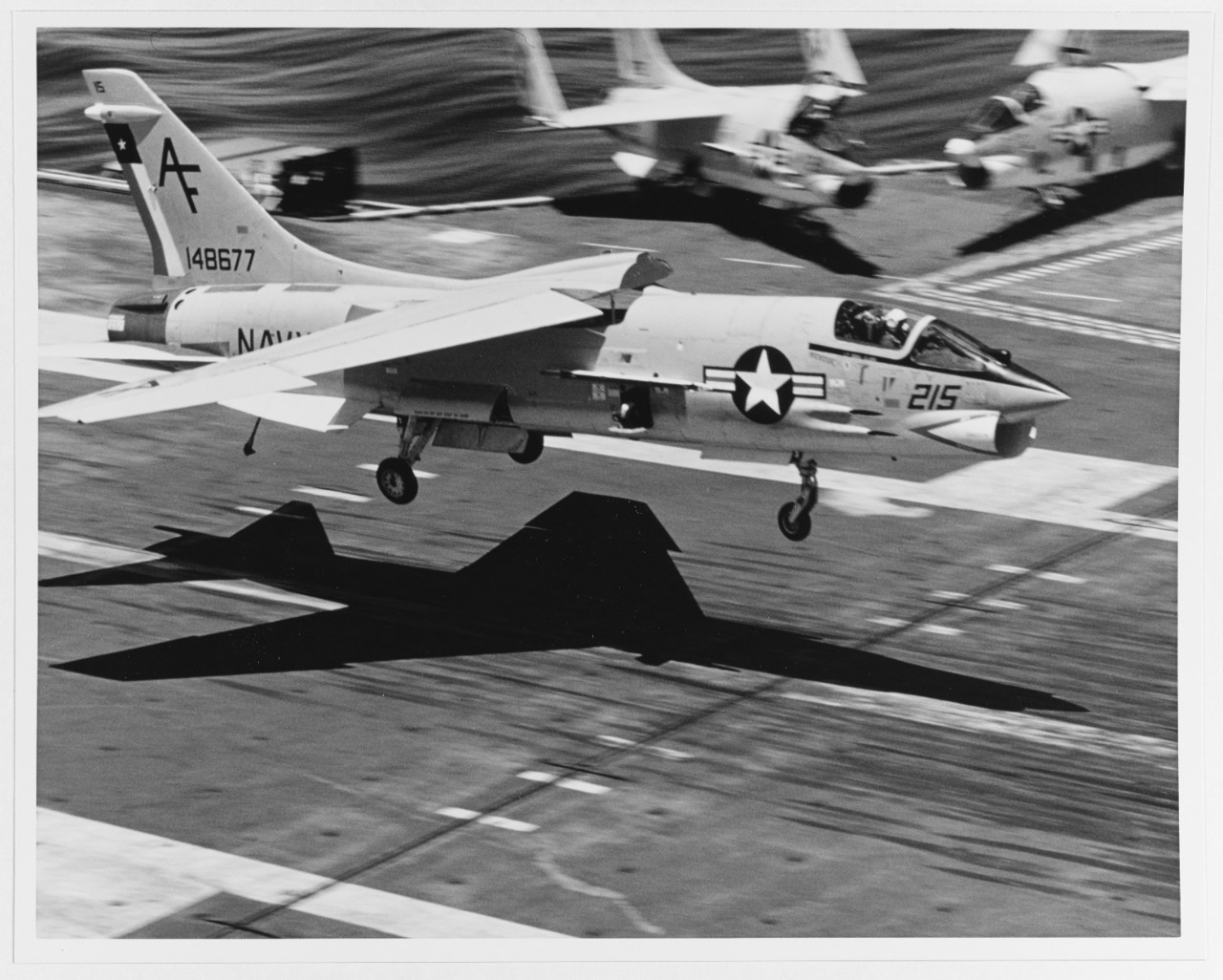F8 Jet Fighter - The Chance Vought F-8 Crusader is an American interceptor transport aircraft. Due to its role as a fighter aircraft, it was given the model designation F-8.
The aircraft made its first flight in February 1955; Crusader was declared operational and entered the US Navy and US Marine Corps in January 1957. A total of 1,260 of this model were delivered.
F8 Jet Fighter

Before the Vietnam War, the F-8 Crusader was the last American jet fighter with a cannon as its main armament system. Aircraft developed since then have relied exclusively on missile armament. However, due to the experience of the Vietnam War, soldiers are now re-equipped with rifles. The original missile-only aircraft fell behind immediately in a 1v1 engagement.
F8 Crusader Hi Res Stock Photography And Images
Due to its artillery armament and great mobility, the Crusader is very good in dogfights and has shot down many aircraft with its artillery armament. The aircraft had great success as an escort and interceptor fighter.
In 1964, the first F-8 E Crusader was also delivered to the French Naval Air Service Aéronavale. The total strength is 42 pieces. The aircraft was slightly modified to accommodate the smaller French aircraft carriers Clemenceau and Foch. They remained in service until 1999, when they were replaced by the French Dassault Rafale M.
In 1977, 35 Crusaders were delivered to the Philippine Air Force to replace the aging F-86 Sabres. The aircraft remained in service until 1991 when they were scrapped. Every fighter pilot wants to fly the plane so badly that no one dares to play with it (or in the sequel). But there's a secret part of them that longs for the fights their Jets prepare. Navy pilots privileged to fly the F-8 Crusader got a pretty bad plane, despite an alarmingly high accident rate. By the end of production, 1,261 F-8s had been rolled off the production line, and all but 155 had been involved in an accident or other serious accident. To be fair, the F-8 entered service while the Navy (and Marines) were still learning how to make the aircraft the primary air/attack fighter to replace piston-powered propeller aircraft. Civil defense contractors are still in their infancy when it comes to manufacturing and designing jet aircraft, so it's not too much to expect that aircraft from that historical period will be somewhat flawed, but that's all due to the learning process.
To be honest, the Crusader is a very popular fighter, although it is not easy to fly. Fast, agile and extremely versatile, it served as both an air-to-air fighter and a bomb truck for Navy and Marine Corps needs, particularly during the Vietnam War. Not to mention, it also has the awesome Sergio Leone-esque nickname, "The Last Gunner," as it was the last American fighter in history to have a cannon (four 20mm cannons to be exact) as its primary armament. It's a rocket. Arriving in Vietnam, the Crusaders not only proved to be a worthy opponent of the MiG fighters exported by the North Vietnamese Air Force. By the time the U.S. fully withdrew from Vietnam in 1975, it had the highest kill count of any American fighter participating in the conflict: an astounding 19:3, meaning only 3 fighters were lost out of 19 Vietnamese MiGs Crusader. The North Vietnamese were particularly aware of the F-8's capabilities as a dogfighter and were somewhat hesitant to challenge the aircraft if encountered. The last F-8 of the war was shot down on May 23, 1972, and this is perhaps the best example of this attitude toward the Crusaders.
Have Gun, Will Dogfight
American Vought F-8H Crusader pilots from Fighter Squadron VF-211 "The General" salute the catapult crew before launch from the aircraft carrier USS Hancock (CVA-19). VF-211 was assigned to Carrier Wing 21 (CVW-21) and deployed to Vietnam from 18 July 1968 to 3 March 1969. (U.S. Navy File Photo/Released)
VF-211, officially known as the "Battlemen", was one of the Navy's most successful Crusader squadrons during the Vietnam War, with eight aircraft claimed downed. Flying out of NAS Miramar, California, they were known throughout the Navy as the "MiG Killers" for their accomplishments during seven deployments to Vietnam. Lt. Gerald "Jerry" Tucker, an F-8J pilot who was on an extended deployment with VF-211 aboard the USS John Hancock (CVA-19), and the rest of VF-211 will drop bombs and fire missiles at ground positions in the North Vietnam. in support of the encircled US and South Vietnamese forces. It probably wasn't what Tucker and his fellow checkers thought they'd be when the Navy informed them they'd be flying Crusader fighter jets, but mid-deployment things soon changed.
The last official MiG was shot down by VF-211 in July 1967 when LCDR Ray Hubbard Jr. shot down a MiG-17 with a pair of Zuni missiles after forcing the MiG pilot to use some very complex flight overrides. VF-211's next kill will be Jerry Tucker's, though much worse than Hubbard's. In late May, Tucker and his companion, LCDR Frank Bachmann, flew the Target Combat Air Patrol (TARCAP) and checked an Alpha attack on an aircraft parked off the coast of Vietnam. The strike birds were supposed to hit predetermined targets in and around Vinh airfield, and to do so they did so quickly and effectively without an air response from the NVAF. By this time, Bachmann and Tucker were very bored and probably wanted to compete. Their radios came alive and it looked like they might get the fight they craved.

It turns out that the lone MiG-17 got its feet wet (meaning it was transitioning from land to water flight) and quickly returned to Alpha Strike Flight, presumably in response to the earlier ground attack that had just been carried out on the aircraft to North Vietnam. targets. The Red Crown crew, observing an active radar advisory zone around the coastal air battle group, called in two VF-161 Charger F-4 Phantom IIs to engage the MiGs, although they were quickly reported lost in bubble. (ie they are confused). Red Crown sent the Phantoms back to the "mothership" (the carrier they came from), and Tucker took the opportunity to join the fight, saying that he and Bachmann were fully armed and ready to strike. Being closest to the NVAF aircraft, they were directed towards the aircraft and Tucker took the lead.
Vought F 8e Crusader By Bagera3005 On Deviantart
The MiG pilot stayed low and Tucker readied his AIM-9C Sidewinder to fire. Gauges in the cockpit indicate that the missile is searching for prey, and within seconds it is ready to fire at its hapless target. But Tucker never got a chance to fire because suddenly the MiG's cowl flew out and flew away, while a flash of light showed that the NVAF pilot had decided to eject rather than confront Tucker. Understandably frustrated that Tucker had almost engaged the enemy fighter but failed to do so, he pulled back on the throttle and repeatedly passed the visibly worried MiG pilot, who was now gently floating to the ground under the parachute turret.
Although we don't know the reason for his launch, many former F-8 pilots like to say that if he had faced a Phantom instead of a Crusader, he probably would have stayed in the cockpit. Evidence of this is the fact that after most NVAF pilots engage the Crusaders head-on, they usually try to leave the fight after the F-8 pilots fire their cannons. This would put them in a solid position to shoot down the F-8 with missiles. Although there is a clear trend, the number of pilots who stay in the US jet furball is generally slightly higher than the number who leave immediately. At first, the Navy denied it was Tucker's murder, though historians and other Navy pilots sided with him. It's a little tiring, but I imagine it's a reassuring feeling for Tucker, Bachman and the rest of VF-211 because the planes they fly are so scary that NVAF pilots would rather rush out than face them. them in air combat. .
VF-211 pilot on cruise in 1972. Jerry Tucker, fourth from left, kneeling. Frank Bachmann, second from right, is also kneeling. (U.S. Navy file photo/released)
Ian is . His work can be found in Military Times, Business Insider, We Are The Mighty, Real Clear Defense, etc. View all posts by Ian D'Costa. If things had been different, the US Navy's best Cold War-era fighter might have been the F-8 Crusader instead of the F-4 Phantom.
F 8 Crusader
But not the legendary Crusaders that used MiG fighters over North Vietnam. Instead, it is
Fighter jet party supplies, f8 fighter jet, latest us fighter jet, fighter jet toys, fighter jet games, fighter jet canvas, f8 jet, fighter jet training, f8 fighter, the newest fighter jet, f 15 fighter jet, ngad fighter jet
0 Comments